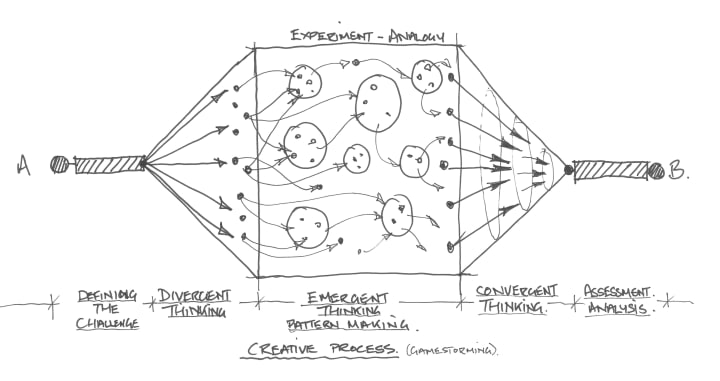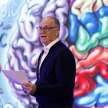3 Modes of Creative Thinking
Divergent, Emergent and Convergent Thinking.

THERE ARE ONLY 2 THINGS YOU CAN REALLY CONTROL, AND THAT’S ATTITUDE AND EFFORT. HOW YOU APPLY BOTH, PRODUCTIVELY, WILL DETERMINE THE SUCCESS, THE QUALITY AND THE QUANTITY OF THE IDEAS YOU COME UP TO SOLUTIONS PROBLEMS.
THE CENTRAL PHASES OF CREATIVE PROBLEM-SOLVING, DIVERGENT, EMERGENT AND CONVERGENT THINKING DEPEND ON THE AMOUNT OF ATTITUDE AND EFFORT YOU APPLY.
I don’t believe it’s possible to generate effective creative solutions to challenges and problems if you’re not both optimistic and have a positive attitude. In order to conceive a new solution, you have to believe that it may be possible. Visualizing a different future outcome from the present situation means that you have to be invested in the outcome and willing to apply the resources necessary to enable it to happen.
There is always a risk involved in any creative thinking. Partly because it must step outside of the norm and our assumptions and because it is, by its nature, disruptive. However with exploration, persistence, a willingness to fail and recover, and by using effective methods, there is a much better chance of success.
It requires a “whole brain” approach. Conscious and unconscious, thinking fast and slow, using all modes of thinking at the right time and in the right sequence.
There are 4 basic steps in an effective creative process:
- UNDERSTANDING – DEFINING THE PROBLEM/CHALLENGE. UNDERSTAND WHAT THE CAUSES OF THE CHALLENGE ARE AND SETTING OUT YOUR GOALS AND OUTCOMES CLEARLY.
- IDEATION – GENERATING IDEAS, EXPLORING POSSIBILITIES AND FINDING EMERGENT PROPERTIES.
- ANALYSIS – EVALUATING IDEAS, SCREENING, AND SORTING. LOOKING INTO THE FEASIBILITY AND PRACTICALITIES OF SELECTED IDEAS.
- DIRECTION – CREATING A PLAN. IMPLEMENTING SOLUTIONS. STRENGTHENING, IMPROVING AND REFINING.

Defining the challenge.
Giving the creative process a structure, a framework within which to frame your thinking is essential. If you try to leap too far forward before you have done the necessary groundwork, the breadth and depth of your solutions will suffer.
The first step is to define the problem. To state the challenge is clear and simple terms. Not accepting the first definitions and pushing further into the problem will reap greater benefits in subsequent steps. The better you know and understand the challenge will begin to generate the ideation for the next step.
It’s also important in stating the problem to understand what the solution may look like. Visualizing the type of solution and the goals you wish to achieve are part of the journey to a solution.

Divergent Thinking. (Attitude)
Imagine a big bang, an explosion of ideas. This phase involves being open to generate ideas and possibilities. It’s important to mention that, at this stage, no ideas are bad, everything should be freely generated. Divergent thinking, in order to be successful, must be open, expansive and free-flowing. Being playful with concepts and ideas has been shown to give rise to more creative solutions. Quantity is important too. You can always discard ideas later, but, if you don’t express those ideas, you won’t know where they may lead.
All creative thinking begins with a question; Why or What-If? By generating many questions you begin to generate many scenarios. This is why optimism and a positive attitude are so important, but judgment should be left outside in this phase. You need to expand in all directions without any thought on the validity or potential effectiveness of an idea.
There are many tools available for helping this process, That’s for another blog.
Divergent thinking is characterized by Metaphor, Daydreaming, Visualisation, Playfulness, Humour, Non-linear, Imagination, Generalization, Hunch, Intuition, Unconscious (gut) reaction.

Emergent Thinking.
Somewhere in the middle of ideation completely new ideas and concepts will begin to form that are greater than the sum of their parts. By exploring the possibilities and generating a number of ideas several new concepts and solutions begin to form out of the combination of those ideas which could not be found in individual ideas.
Emergent thinking happens when you move towards completely unforeseen possibilities, that only become apparent when comparing and combining generated ideas.

Convergent Thinking. (Effort)
This is often called “the hard skill-set”. Like Big-Bang, but in reverse. Here you select your best opportunities. Honing your ideas and concepts down to those that you believe are the most viable and feasible. This involves logical and analytical reasoning. Moving forward to a less expansive and more converging viewpoint. Applying rational and deliberate thinking to begin t bring ideas to the beginning of a plan.
Much more structured and much more organized, applying focussed techniques to reject those ideas that don’t lead to effective solutions. Sometimes, however, you may extract the most effective ideas and restart the ideation process. This iteration is often highly effective in squeezing every last drop out of an idea.
Convergent thinking is characterized by Linear, Analytical, Reason, Logic, Precision, Consistency, Critical thinking, Facts, Rationality, Deliberate, Work (effort), Reality, Direct, Focussed, Sequential, Number, Conscious.
Whole Brain Thinking.
It’s not that you need one or the other type of thinking. You need all modes of thinking, but each one in its own moment and in concert with the others. So, it’s not just thinking fast and slow, it’s not left brain, right brain, but the whole brain.

With grateful thanks to Dave Gray, Sunni Brown, James Macanufo and Chris Griffiths.







Comments
There are no comments for this story
Be the first to respond and start the conversation.